Stonewall Gas Gathering companies running roughshod over people, nature and the law
ALUM BRIDGE, W.Va. – The West Virginia Department of Environmental Protection (WVDEP) has issued at least 12 Notice of Violations to the contractors of the Stonewall Gas Gathering (SGG) pipeline since mid-June. The violations are for not following best practices and for causing conditions which pollute the state’s streams.
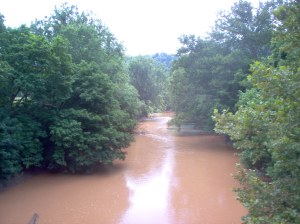
The SGG is being built by Stonewall Gas Gathering, LLC, which was incorporated in Delaware on June 4, 2014. SGG is a subsidiary of Momentum (officially M3Midstream), based in Texas and Colorado. The Stonewall Gathering line is part of Momentum’s Appalachian Gathering System (AGS). The SGG will connect to the AGS in Harrison County and terminate in Braxton County, where it will connect to the Columbia pipeline. It runs also through Doddridge and Lewis counties.
The company laying the pipeline is Wisconsin-based Precision Pipeline, LLC. According to the company’s website, “We have the experience and expertise to safely complete any project while maintaining total environmental compliance with minimal impact to landowners.”
That’s what the company’s website says. The state of West Virginia, residents being impacted by it, and at least one independent environmental scientist say otherwise.
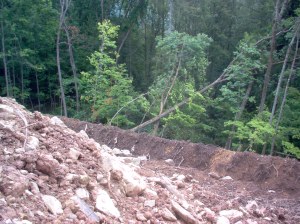
In mid-July, Jamie Tallman, an environmental inspector with WVDEP surveyed an approximately six mile stretch of the 55-mile pipeline and found that the construction had impacted at least eight stream crossings on Right Fork, Laurel Run, Indian Fork, Big Isaac Creek and Meathouse Fork in Doddridge and Harrison counties. As a result of those visits, he issued 10 Notice of Violations to SGG, though Precision Pipeline is doing the actual work.
He cited poor sediment controls at stream crossings, poor perimeter controls, and other problems such as “marginal” conditions for slope breakers. He noted also, “Multiple earthen slips were observed … two of which were documented to impact state waters but had not been reported.”

That brings to 12 the number of Notice of Violations for this project, the other two also issued by Tallman. One was issued in June for damage done near the community of Big Isaac in Doddridge County and another in early July near the same area. Read more: Standing Their Ground.
Meanwhile, Diana Gooding, a Gilmer County farmer who lives near the Lewis County line, has been taking residents from Virginia and southeastern West Virginia on tours of the pipeline route to witness first-hand the impact of the construction on the region’s delicate watershed. On Aug. 11th, after a heavy rain, Gooding noted, “Goosepen Road today was alive with devastation. Running over the sediment barriers was the mud to the stream as they worked away with heavy equipment despite the deluge of rain we had last night.” She observed, “The equipment and bulldozers were sliding backwards and sideways just trying to take pilings up the hillsides.”
She offered, “It is awful what they are being allowed to do. All of the little streams below are getting trashed big time.”
Independent Environmental Assessment
One such person who accompanied Gooding on one of her trips along the pipeline route is Autumn Bryson, a Greenbrier County-based environmental scientist and owner of Autumn Environmental. On July 18th, along with several others, they visited numerous sites in Lewis, Harrison and Doddridge counties. From that visit, Bryson conducted a Sediment and Erosion Control Assessment. The Assessment was accompanied by numerous photos supporting her assertions.
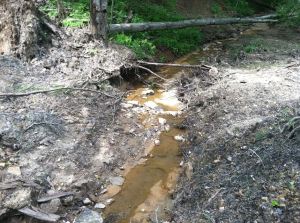
Photo by Autumn Bryson
She observed, “Silt fences, filter socks, and hay were the methods used to control sedimentation and erosion. Failing silt fences were observed at Goosepen Run Stream Crossing along the pipeline route, allowing sediment to enter the nearby stream. The sediment and erosion control measures used are inadequate for the amount of exposed soil and high precipitation events that are common to this region.”
She continued, “Along Sleepcamp Run road, soil was piled high on steep slopes above the road. Silt fences were the only method used to hold the soil in place. There were several occurrences where the silt fences were overloaded and torn due to the weight of the rock and soil. One fabric silt fence is an inadequate method to stabilize an entire hillside. Silt fences were not designed for this use. With a heavy rain event, a landslide could occur causing a safety hazard on public roadways.”
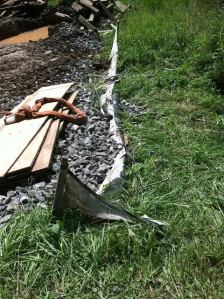
Photo by Autumn Bryson
On another crossing in Lewis County, Bryson observed, “Along Copley Road, the pipeline route crosses Sand Fork. At this location, sedimentation was observed in the stream. The silt fences were overflowing allowing the overflow to empty into the nearby stream. The high volume of soil is too much for the silt fence to bear.”
Additionally, she observed, “The Stonewall Gathering pipeline crosses Left Millstone Road and continues down the mountain to cross Millstone Run. Sedimentation was observed in Millstone Run. Filter socks and silt fences were attempting to control the erosion but the volume of soil was too much to hold the hillside in place. The runoff has breached the silt fence and evaded the filter sock. There was also a tear in the filter fabric on the temporary bridge. This hole in the filter fabric allows runoff to flow directly into the stream below further exacerbating the sedimentation issues.”
She asserted also, “An illegal stream crossing was observed where the Stonewall Gathering Line crosses Elk Lick. It appeared that heavy equipment was driven directly through the streambed. There was no stream crossing permit signage in place. No sediment and erosion control methods were used and as a result there was significant sedimentation and damage to the stream bank.”
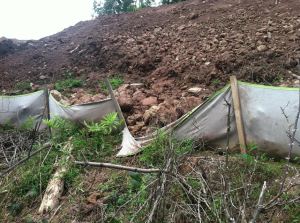
Photo by Autumn Bryson
At yet another stream crossing, she noted, “The Stonewall Gathering line crosses the Right Fork of Kincheloe Creek. Another erosion control measure failed at this stream crossing. The silt fence was unable to contain the volume of soil eroding from the hillside. As a result, the soil breached the silt fence and spilled into the stream.”
She concluded, “Based on observations made during the site visit to the Stonewall Gathering pipeline, the Sediment and Erosion Control Plan is ineffective for a construction project of this magnitude. Silt fences, filter socks, and hay are not able to control erosion and reduce sedimentation into nearby streams. At each location there were instances where the erosion control methods failed impacting the surface waters in the vicinity. The silt fences are unable to bear the load of soil excavated during construction. Filter socks are inadequate at controlling runoff. Filter fabric has been compromised leaving it ineffective. In addition, there is an area where no best management practices are used and heavy equipment has been driven directly through a streambed. These sedimentation and erosion control issues need to be addressed. A more effective plan for controlling sedimentation and erosion needs to be implemented to reduce impacts on nearby streams.”
A resident’s experience
Meanwhile, a farmer near Jane Lew in Lewis County has had more than one confrontation with Precision employees, as well as state workers purportedly on site to monitor the work of the construction crews. Going home on his motorcycle after a trip to Pennsylvania, Tom Berlin was more than a mile up a road to his home only to find it blocked by construction activity. “They were breaking rock and digging a trench. They had a couple of those big iron plates across covered with about four eight-inch-high piles of loose dirt and rock fragments on the best of the two plates. They stopped one machine, but not the big jack hammer and told me I could cross. It was a sort of a tricky crossing, but doable. They made no effort to clear or smooth the path for me, all looking to see if I would make it or chicken out and turn back. I was especially upset that they kept the jack hammer working right alongside me the whole time.”

He continued, “I berated them for not posting a sign at the end of the road, rather than making people travel a mile-and-a-half up a dirt road to find the way blocked. I said I wanted to talk with a supervisor. A man in a white pickup met me at the top of the hill and I gave him a piece of my mind. I then walked back down and found that there was a state road employee in his truck sitting there watching and supposedly making sure they were doing things right. He kept insisting they had a permit and all was OK. He could not explain to me why they did not need to post a warning sign, except to say that they put a notice in some newspaper recently.”
Berlin revealed also, “Then I noticed a guy in a 4-wheeler apparently taking a nap. He bestirred himself and asked if all was OK. I asked if he was a supervisor on this crossing and he assured me he was. So, I lit into him a bit. He explained that he had 55 miles of 36-inch pipeline to lay and he did not have the time to accommodate the needs of every local who might want to use the public road.”
Berlin said the man refused to give him his name.
© Michael M. Barrick, 2015
This company is blocking our roads and devastating our hillsides while the state of WV and our Senators and Representatives do nothing to stop them. They refused to do the required public hearings and are now just chewing their way through the countryside. Again, WV bows to Big Energy and sacrifices our land and our rights for a little cash and a few short-term jobs! Truly this state is a sacrifice zone for the rest of the country!!!
Reblogged this on realeyezlife and commented:
Excellent blog!
Picked up your book last Friday (was traveling for the past few weeks) and I’m half way done – I love it! You are so on point with all your points – particularly about the arts and it’s impact on society…
[…] Articles West Virginia Pipeline Project Cited for Several Violations Fracking Poses Threats to Public Health Say Experts A Dirty Dozen Reasons to Oppose Fracking WVDEP […]
[…] The West Virginia DEP did issue several Notice of Violations to Precision Pipeline, the company that built the pipeline. However, it did so only after numerous complaints from citizens. (Read more here). […]
[…] not worse and will of course affect many more private landowners.” She shared also that while the Stonewall Gas Gathering line was being constructed last year, a supervisor with one of the involved companies said “… they […]
[…] West Virginia Pipeline Project Cited for Numerous Violations […]
[…] This next article, Standing Their Ground, tells of the determination of a farming family in Doddridge County, W.Va. to be treated justly when a company building an intrastate pipeline in West Virginia last summer ran roughshod over everyone along their 56-mile path. While this is not the ACP, it does provide insight into what residents in the way of a gas company can expect. Because of complaints from folks like these, and the work of some reporters, the state did issue citations. Read more here: West Virginia Pipeline Project Cited for Numerous Violations. […]
[…] gas companies don’t care if they have to seize your property, spoil our streams and rivers, and endanger communities, in our region, or […]
[…] West Virginia Pipeline Project Cited for Numerous Violations […]
[…] West Virginia Pipeline Project Cited for Numerous Violations […]
[…] West Virginia Pipeline Project Cited for Numerous Violations […]
[…] Courtesy Submission. Feature (home page) photo by the author. Photo of pipeline construction in West Virginia. During construction of this pipeline, the companies building the pipeline were cited numerous times for failure to maintain proper erosion controls. Read the story: ‘West Virginia Pipeline Project Cited for Numerous Violations’ […]
[…] West Virginia Pipeline Project Cited for Numerous Violations […]
[…] West Virginia Pipeline Project Cited for Numerous Violations […]